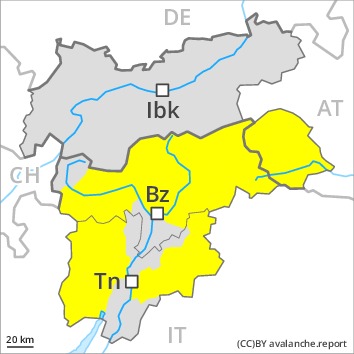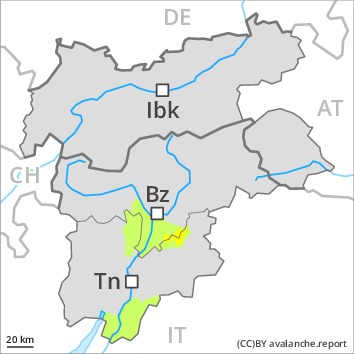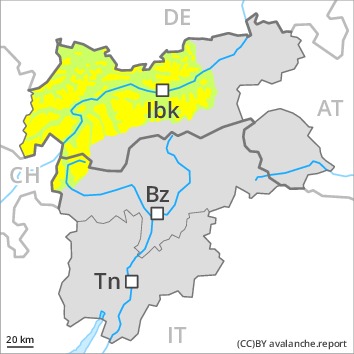
Danger level
 | 2200m
|
Avalanche Problem
 | | Wind-drifted snow |
|  | |  |
 | | Gliding snow |
|  | |  |

Wind slabs require caution. Caution is to be exercised in areas with glide cracks.
The fresh and somewhat older wind slabs are in some cases prone to triggering on steep shady slopes above approximately 2200 m. Mostly avalanches are only small but can be released also by a single winter sport participant. The prevalence of avalanche prone locations and likelihood of triggering will increase with altitude.
On very steep grassy slopes and on sunny slopes more gliding avalanches are possible, even quite large ones. Areas with glide cracks are to be avoided. Slight increase in danger of wet snow slides as a consequence of warming.
Snowpack
dp.6: cold, loose snow and wind
dp.2: gliding snow
In some regions up to 10 cm of snow has fallen. As a consequence of a strong wind from westerly directions, mostly small wind slabs will form since Tuesday. In some places wind slabs are lying on surface hoar, especially on shady slopes. In its middle, the snowpack is well consolidated. Towards its base, the snowpack is faceted, especially on shady slopes above the tree line, as well as in all aspects in high Alpine regions.
Tendency
The avalanche danger will persist.

Danger level
 | 2200m
|
Avalanche Problem

Fresh wind slabs require caution.
The fresh and somewhat older wind slabs can be released easily in some places above approximately 2200 m. This applies in particular adjacent to ridgelines and in gullies and bowls.
On very steep grassy slopes and on sunny slopes only isolated gliding avalanches are possible.
Snowpack
dp.6: cold, loose snow and wind
As a consequence of the sometimes strong wind the previously small wind slabs will increase in size moderately. In some places wind slabs are lying on the soft surface of an old snowpack, especially on shady slopes.
In its middle, the snowpack is well consolidated. Towards its base, the snowpack is faceted.
At low and intermediate altitudes only a little snow is lying.
Tendency
The avalanche danger will persist.

Danger level
 | 2200m
|
Avalanche Problem
 | | Persistent weak layer |
|  | |  |
 | | Wind-drifted snow |
|  | |  |

Weak layers in the lower part of the snowpack are treacherous. Wind slabs require caution.
Weak layers in the lower part of the snowpack can be released in some places by individual winter sport participants. Caution is to be exercised in particular on steep shady slopes above approximately 2200 m, especially in areas where the snow cover is rather shallow, as well as at transitions from a shallow to a deep snowpack, when entering gullies and bowls for example. Avalanches can be triggered in the faceted old snow and reach a dangerous size. In the regions with a lot of snow the situation is more favourable.
As a consequence of a sometimes strong wind from westerly directions, wind slabs will form since Tuesday. These are rather small but in some cases prone to triggering, in particular on shady slopes. The number and size of avalanche prone locations will increase with altitude.
Slight increase in danger of wet snow slides as a consequence of warming.
Snowpack
dp.1: deep persistent weak layer
dp.6: cold, loose snow and wind
In some regions 10 cm of snow, and even more in some localities, has fallen. The sometimes strong wind will transport the fresh and old snow. In some places wind slabs are lying on surface hoar.
Steep shady slopes: The old snowpack will be prone to triggering in some places. Towards its base, the snowpack is faceted and weak. Whumpfing sounds and the formation of shooting cracks when stepping on the snowpack are a clear indication of a weakly bonded snowpack.
Steep sunny slopes as well as low and intermediate altitudes: The snowpack is largely stable and its surface has a melt-freeze crust.
Tendency
The avalanche danger will persist.














